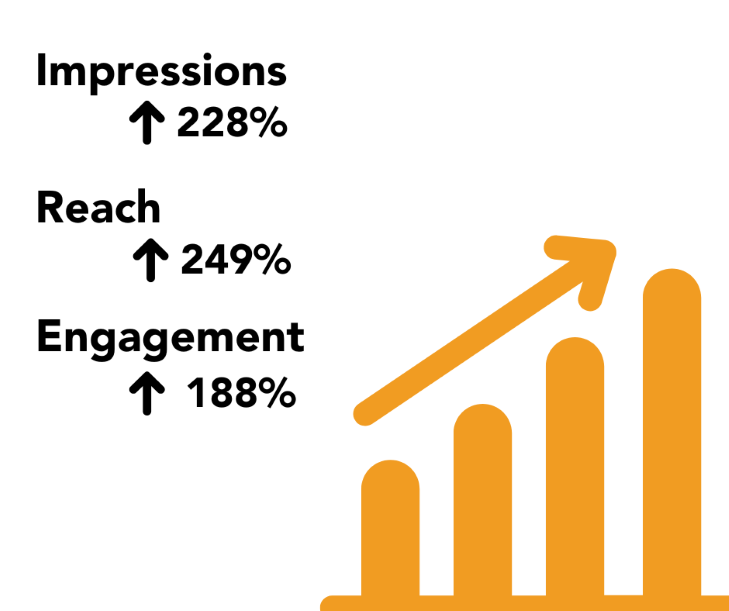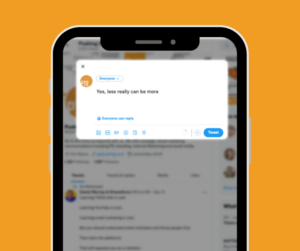Yes, Less Really Can Be More
By Hannah Ramsey

Social media is fun and daunting, user-friendly yet complex – especially when you’re using it for your business. There are tons of resources and people out there saying, “this is what the algorithm is doing now,” or “you should post this many times per day to stay relevant.” It’s hard to know what the right answer is.
The truth is, there is no definitive, right answer for how to use social media. The best thing to do is observe and listen to what your audience is telling you, whether directly or through their behavior online (i.e., analytics). With a foundation of data vs. speculation, you can make decisions about what channels your business should be on, how often you should be posting, and what content to share. In many cases, less is actually more.
Choosing the right channels
It’s unlikely your target audience uses every social media platform, and it’s unrealistic to use all these platforms as a part of your marketing strategy. Instead, it’s essential to align your efforts with the activity of your target audience and effectively utilize those select channels.
For example, are you hoping to reach other businesses or recruit employees? LinkedIn, designed as a professional networking site, would be a good channel to focus your efforts. Are you a highly visual business looking to appeal to a younger demographic? Then picture and video-driven Instagram would be the way to go.
Also keep in mind the type of content and volume needed when selecting channels. Will you be able to generate enough images and videos to maintain an Instagram account? Select a channel mix that combines both where your audience is and your capabilities, bandwidth, etc. A quality representation of your brand is more important than a poor one spread across too many channels with too little content.
Prioritize quality over quantity
It’s not about how much you post – it’s about what you’re posting. Brands must find a delicate balance between capturing attention, generating awareness, and making their message memorable without overwhelming or annoying their audience. A daily, salesy post is not the prescribed plan here.
You’ll create a deeper connection and generate more interest by aligning your content with what your target audience cares about, providing them with value-added content vs. sales promos. Monitoring their engagement (likes, shares, comments) through channel analytics will enable you to determine how often to share.
For example, suppose you are a restaurant targeting millennials. In addition to promoting money-saving specials, focusing on the overall experience would align with how millennials make their purchasing decisions. On the other hand, if you’re a sports car brand targeting retirement-aged individuals, sharing tips on how hobbies or causes of interest could create connection and segue nicely into how your product would enhance their life in retirement.
Looking at the monthly performance of your social media will tell you whether your strategy is working. Are users liking, commenting or sharing your posts, or are they sitting unseen and untouched? Look at what content is getting the most attention and center future posts around that topic. Also look at the time of day when you get the most engagement and schedule posts then. Try posting less but with more impactful messaging for one month and see how your audience reacts.
Real-world case in point
Let’s look at a real-world example of a “less is more” strategy we employed for a business.
When we began managing the social media presence for a national bank, an existing posting schedule was in place that was frequent but lacked strategy. The results were lackluster, showing little to no engagement from their audience on the published posts.
Taking a quality over quantity approach, we strategically reduced the total amount of posts shared organically by the bank compared to previous months, while making each post more thoughtful, engaging, and impactful.
Our specific organic content strategies included:
- A dedicated campaign to showcase the bank’s associates, humanizing the brand
- Value-added content that showcased the bank’s dedication to educating clients and followers in their areas of expertise
- A campaign celebrating the clients of the bank, many of whom are well-known within their local communities as business leaders, humanitarians, and otherwise
By observing previous audience behavior and adjusting based on their engagement, key performance indicators improved by as much as 249% in just one month!
- Impressions, or total content views, increased by 228%
- Reach, or total users who saw the content, increased by 249%
- Engagements, or actions taken on content, increased by 188%
Hannah Ramsey is the client relations and marketing specialist with Pushing the Envelope, Inc., a strategic marketing communication firm based in Fort Myers, Florida, servicing clients regionally and nationally. She enjoys developing a partnership with her clients and coming alongside them to help reach their business goals. Visit getpushing.com/contact for more information.




